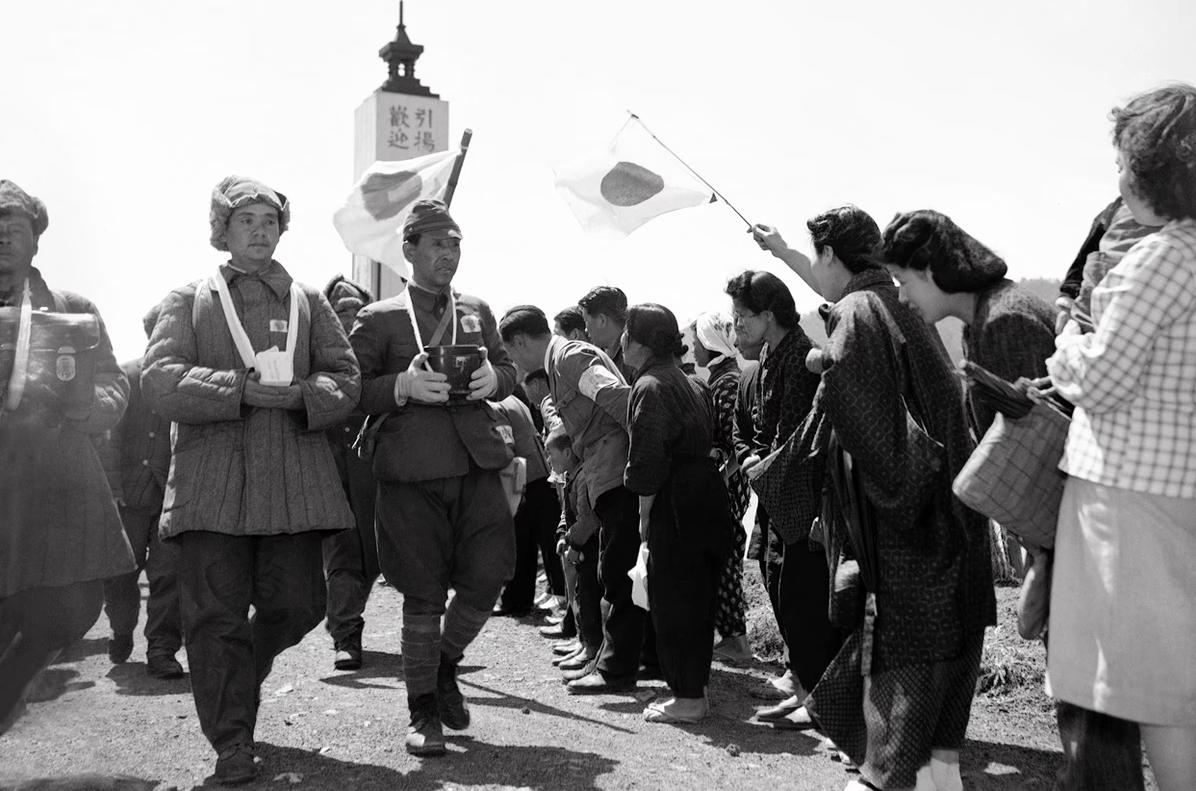"They hauled me up like a caught fish and I prepared fordeath. Insteada medical officr examined my injuries while sailor brought coffee. Real coffee, hot with sugar and cream. I hadn't tasted coffee since 1942. Thesailor bappologized that they weere out of donuts."
--Jpnerse pilot brought board the 'USS Missouri', 1945
Strangely, as fiercely as the Japanese fought during the War, the Japanese had one of the largest numbers of POWs after the War--probably about 2.5 million men. Here we are not counting Japanese forces on the Home Islands preparing to resist the American invasion. These forces were not interned by the Allies. The Japanese were allowed to demobilize them and send them home. They were not held as POWs. Only a handful of Japanese soldiers surrendered during actual war-time battles. Actually many POWs were men that were so badly wounded that they could not resist being taken prisoner and were at first deeply ashamed as they recovered. These were extremely small numbers of men in World War II terms. One estimate puts it at something like 35,0000 men, although there are slightly lower and higher estimates. Something approaching 1 million men surrendered to the Soviets in Manchuria at the end of the War. Slightly more than 1 million men surrendered to the Chinese immediately after the War. We do not yet have the number who surrendered to the British Empire forces in Southeast Asia and the Pacific, but it would have been under 1 million men. Only about 50,000 men were left when Gen Yamashita finally surrendered to the Americans on the Philippines. A reader writes, "It's not strange that so many Japanese soldiers surrendered after the war. They were still obediently following the orders of the Emperor to surrender." Absolutely correct, especially with the soldiers. The officer corps was more of a wild card. But it is also true that the Emperor was afraid to resist the military as they moved toward war because he feared being removed. And the military did invade the Imperial Palace to stop his surrender broadcast (August 1945). I have always wondered what would have happened had we not used the atomic bomb. I personally think it was the bomb which changed the mindset of the Imperial officer corps, or at least gave them a plausibly honorable excuse. That was the exit that th Emperor chose. It was, however, unclear at the time what the Japanese units in Southeast Asian were going to do. As with the Germans, the fate of the Japanese POWs depending on whether they were held by the Soviets or Western Allies. The Japanese were concerned about how they would be treated by the Chinese, given the barbarity of their treatment of Chinese soldiers captured. The Chinese Nationalists, however, treated the Japanese correctly. We are unsure about the Communists, but believe that except for Manchuria where the Japanese surrendered to the Soviets, most Japanese forces surrendered to the Nationalists. One notable aspect of the Japanese POW story is that Japanese soldiers were not allowed to surrender, what ever the circumstances. Most countries were concerned about their POWs and tried to aid them such as sending packages and letters. (The Japanese and Soviets were an exception.) The Japanese military government during the War made no such effort and considered such men as cowards and traitors. The Government sought to suppress information about captured personnel and did not inform relatives when the Red Cross provided POW information. In fact after the war, the POWs that had surrendered during the War were initially treated with considerable disdain. This gradually changed as the Japanese people came to have a better, if imperfect understanding of the War.
CIH -- WW II

Navigate the CIH World War II Section:
[Return to World War II POWs: Country trends]
[Return to Main World War II coiuntry POW page]
[Return to Main World War II POW page]
[Return to Main military style page]
[About Us]
[Biographies]
[Campaigns]
[Children]
[Countries]
[Deciding factors]
[Diplomacy]
[Geo-political crisis]
[Economics]
[Home front]
[Intelligence]
[POWs]
[Resistance]
[Race]
[Refugees]
[Technology]
[Totalitarian powers]
[Bibliographies]
[Contributions]
[FAQs]
[Images]
[Links]
[Registration]
[Tools]
[Return to Main World War II page]
[Return to Main war essay page]
[Return to CIH Home page]
Created: 6:53 PM 4/12/2022
Last updated: 6:54 PM 4/12/2022



